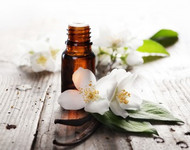Beginners Guide to Essential Oils
Posted by Lyn Gardenchild
What are Essential Oils?
Essential oils are organic compounds derived from plant sources such as roots, bark, flowers and seeds. They are complex chemical compounds and not technically oils at all! They are extracted using a variety of methods to capture the scented particles, leaving many of the other chemical constituents of the plant behind.
Aromatherapy is a complementary therapy based on holistic principles, using the application of essential oils to improve mental, physical, emotional and spiritual well-being. Oils can be applied in a variety of ways apart from massage.
How does aromatherapy work?
Skin absorption
Most of the chemical constituents of essential oils have a molecular weight of less than 1000m (m = weight of molecule). Theoretically, any substance with a molecular weight below 1000m should be absorbed by the skin (Ref. Food Cos. Tox. 1989 v 27:479). There is controversy over the issue of skin absorption. Some parts of an essential oil can be absorbed into the skin, but there is no evidence to prove that it is then absorbed into the underlying tissues via the capillary and lymphatic vessels at the dosages used in ordinary aromatherapy mixes.
Inhalation
There is evidence that essential oils are absorbed into the bloodstream when inhaled. The many blood vessels in the lungs absorb the oils and circulate them throughout the body. Our sense of smell connects directly with the limbic system of the brain, which processes memories, associations and emotions.
Ingestion
We ingest oils in many foodstuffs and pharmaceuticals where the essential oils are widely used as flavourings, for example in peppermint toothpaste and chewing gums, flavoured drinks and mouthwashes. It is unwise to drink essential oils unless prescribed by a medical herbalist.
Choosing essential oils

When choosing essential oils you will need to take into account the effect you would like them to have on you and your environment, any related safety issues, your budget - some oils are harder to extract than others and may be available only from limited regions, so prices differ greatly - and, of course, the fragrance.
If you find a particular scent unpleasant, your dislike of it may reduce its potential benefits to you. We have described the fragrance as well as the properties of each oil as best we can to assist you in selecting oils that are unfamiliar to you.
Contraindications
Some oils are not recommended for people of certain ages or suffering from certain conditions. Refer to the safety information in aromatherapy books and the Which oils can be dangerous? section below. Contraindications are also given for each oil in the shopping area.
Use your intuition
Don't forget, if all else fails, to use your intuition. This is one of the most valuable tools in making the best choice. If you are drawn to an oil, but your brain is saying you should choose another, then why not trust your intuition? It may have a wonderful surprise in store for you!
How do I know if an oil is pure?
Not all essential oils are pure. Some are adulterated with or 'extended' by inferior oils and synthetics, or composed of several different oils to achieve a specific smell. These are known as 'natur identical'. Always buy oils from a reputable supplier. Cheap oils are often synthetic or adulterated with cheaper or lower quality oils.
How do I use essential oils?
In the bath
Using essential oils in the bath is an extremely effective way of influencing mood, although rather wasteful as much of the essential oil sticks to the sides of the bath. Add essential oils to a spoon or two of oil or soap solution and add it to the bathwater just before you get in - otherwise the oils will evaporate before you have a chance to enjoy them or benefit from absorption via the lungs and nose.
Dosage: up to 10 drops in 10ml (2 teaspoons) oil or soap solution, or directly to the water.
Take care when using oils in the bath as some can sting. Lemon, orange, grapefruit, aniseed, camphor, clove, eucalyptus, ginger, juniper, black pepper, peppermint, sage, savory, spearmint, and thyme should be used in very small dosages - no more than 2 drops to a bath.
Alternatively, you can apply a massage blend to the body, then sit in a warm bath for a while.
Footbaths
A footbath is useful when someone is immobile or too fragile for other methods. This is an extremely effective stress-relief and pick-me-up at the end of a hard day and in hot weather.
Dosage: use 4 drops in a bowl or footspa of warm water and soak feet for about 20 minutes.
Body massage
Dosage: up to 6 drops in 10-15ml (2-3 teaspoons) of carrier oil or lotion.
Facial massage
Facial skin requires special care as it tends to be delicate, show more signs of stress and toxic overload, and is generally more exposed to the wind, sun and atmospheric pollutants. For facial massage, select an appropriate carrier oil and use a lower dosage of essential oil than that for body massage. As the face is a small area, 5ml of total mix are usually sufficient.
Dosage: 1-3%, or 1-3 drops, in 5ml (1 teaspoon) of carrier oil (use an even higher dilution for very sensitive skin).
Localised massage
Can be applied to small areas, for example stiff joints, sprains and cramps (e.g., stomach and period pains). As the area to be covered usually requires fast action the dilution used is often lower than that for body or facial massage, but always make sure that you are using a safe dosage.
Dosage: 5%, or 10 drops, in 5ml (1 teaspoon) carrier oil. Ensure that you do not exceed the maximum safe dosage - refer to Dosages for adults and children and Which oils can be dangerous?.
Water compresses
Certain situations require fast action, so low dilutions are used. Conditions like sprains, cuts, bruises, sunburn, insect bites, rashes, large areas of skin infection and inflammation respond well to this method.
Dosage: up to 12 drops in 100ml water, hot or cold depending upon the situation. Agitate the water and quickly soak a piece of sterile gauze in it, wring it out and apply to the affected area. The treatment can be augmented by the application of ice packs or heat pads as appropriate.
Neat application
Cuts, insect bites, spots, cold sores, verrucae, warts and athlete's foot can be treated with neat tea-tree and/or lavender oil. Apply with a cotton bud. If the area is cracked and dry cover with a barrier cream after 10 minutes. Note: tea-tree may cause irritation and dryness, so treat with respect.
Fragrancers
Essential oils can be diffused into the air through dry heat, steam or mist or by fan-assisted evaporation. This is an effective way of changing mood, purifying the atmosphere or getting essential oils into the respiratory and olfactory systems. The commonly available types of fragrancer are as follows:
Standard fragrancers: oils are added to a small bowl of water, which is heated by a nightlight. Cheap, but not safe, as there is an exposed flame.
Electrical fragrancers: oils are dropped onto a metal plate heated by an electrical element. This is safer, but the heat can damage the oils.
Light bulb rings: oils are dropped into a channel in a small ring that fits over a table lamp bulb, which heats the oils.
Radiator fragrancers: small essential oil containers that clip onto metal radiators, which heat the oils. Take care because essential oils can spoil paintwork.
Electrical diffusers: a fan blows across the essential oils container, causing evaporation. Safe, no heat damage to oils or fire risk, but expensive.
Inhalations: Use for colds, flu, sinusitis and asthma, or in any situation that requires fast relief from congestion and respiratory or emotional problems. Use 3-5 drops of an appropriate oil in a cupful of hot (not boiling) water and inhale.
Alternatively, fill a bowl with hot water, add appropriate essential oils and then sit bent over the bowl with a towel over

your head forming a tent to keep the vapours in. This can be dangerous and should not be used for unsupervised children. The bowl method also makes some people feel claustrophobic, and should not be used on asthmatics except with great care. People with thin, sensitive skin or skin that has a tendency to thread veins should not use this method. Note: keep your eyes closed to prevent irritation.
Sprays: Fill a plant spray bottle with water. To each 300ml add 8-10 drops of essential oil. Shake bottle vigorously before each use, as oils do not dissolve in water. Use as a room freshener or an insecticide using appropriate oils. Avoid getting spray in eyes as this may cause irritation. Do not spray on painted surfaces as oils may stain paintwork.
Dosages for adults and children
Please always refer to the dosage table and safety chart when selecting, and using essential oils for adults.
ADULTS
| PURPOSE OF BLEND | NO OF DROPS ESSENTIAL OIL | QUANTITY OF CARRIER |
| Facial massage/skincare | 1-3 | 5ml (1 tsp.) |
| General massage | 5-10 | 15ml (3 tsp.) |
| Localised areas | max. 20 | 10ml (2 tsp.) |
| Baths/footbaths | max. 10 | bowl or bat |
Children
Children have delicate skin and eyes and are, on the whole, very sensitive to smells. For these reasons, great care is needed when selecting and blending oils. Ask yourself if it is necessary to apply the oils to the body, or whether fragrancing is more appropriate. Take care when using low dilutions in fragrancers as the vapour may sting a child's eyes and delicate mucous membranes. Do not leave children unsupervised when using fragrancers with nightlights.
6 months-2 years 1 drop in 10ml (2 teaspoons) almond oil Use only good quality oils with high odour intensity (e.g., rose otto, neroli, terpene-free lavender and Roman chamomile). Two drops of lavender on a handkerchief tied to a child's cot can help if the child has difficulty sleeping. If the child has a cold, eucalyptus or tea-tree can be used in the same way to ease congestion.
2-5 years 1-3 drops in 10ml (2 teaspoons) carrier oil. See above for safe oils to use.
5-12 years Use half adult dose and increase range of oils used
12+ Use adult dose
Which oils can be dangerous?
Below is a list of some of the traditionally accepted contraindicated oils for specific conditions. There is little scientific research to support most of these contraindications.
Pregnancy Basil, cinnamon, clary sage, cypress, fennel, jasmine, juniper, marjoram, myrrh, origanum, pennyroyal, peppermint, rose, rosemary, sage, savory and thyme
Breastfeeding Mint, parsley, sage and jasmine (research has shown that jasmine inhibits milk production in lactating mothers)
High blood pressure Cypress, eucalyptus, ginger, rose, rosemary, sage and thyme
Low blood pressure Clary sage, garlic, lavender, lemon, marjoram and ylang-ylang
Epilepsy Fennel, hyssop, rosemary, sage and wormwood
Care when using machinery or driving Clary sage and vertivert
Care if drinking alcohol Clary sage
Hazardous oils
These oils are never to be used in any form in therapy:
Almond (bitter), Boldo Leaf, Calamus, Camphor (brown), Camphor (yellow), Horseradish, Jaborandi leaf, Mugwort, Mustard, Rue, Sassafras, Sassafras (Brazil), Savin, Southernwood, Tansy, Thuja (cedarleaf), Thuja, Plicata, Wintergreen, Wormseed, Wormwood.
Not to be used on the skin, although can be used in high dilution in fragrancers
Cassia, Clove buds, Clover leaf, Clove stem, Cinnamon bark, Costus, Elecampane, Fennel (bitter), Origanum, Origanum (Thymus capitatus), Pine (dwarf), Savory (summer), Savory (winter).
Compiled and written by Lyn Gardenchild DipIFA IEB Aromatherapist and IEB registered tutor
© holisticshop 2000. All rights reserved



